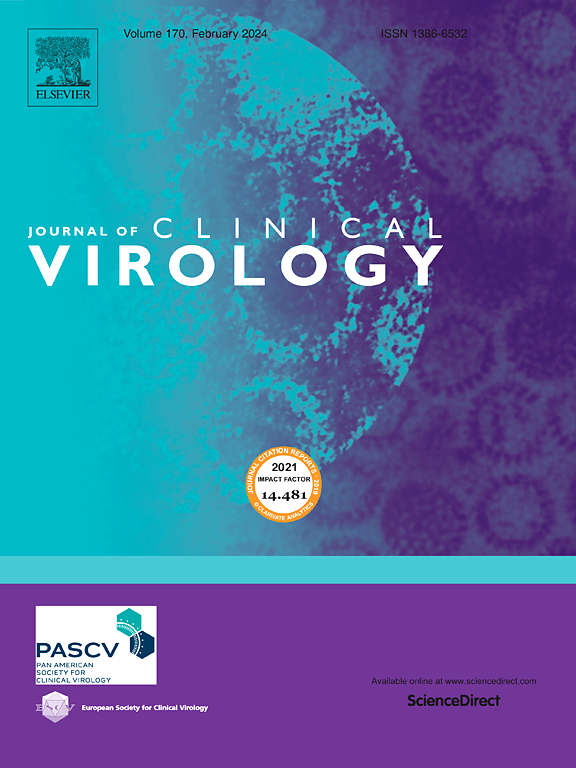印度南部一家三级医疗中心用于检测狂犬病抗体的内部酶联免疫吸附试验的标准化和评估
IF 4
3区 医学
Q2 VIROLOGY
引用次数: 0
摘要
背景快速荧光聚焦抑制试验(RFFIT)是一种基于中和的狂犬病抗体检测方法,是检测狂犬病抗体的黄金标准。消灭犬媒狂犬病国家行动计划(NAPRE)是一项国家计划,其战略是建立酶联免疫吸附试验(ELISA)来检测狂犬病抗体。研究设计 2023 年 4 月至 9 月,南印度一家三级医疗中心的临床病毒学部门开展了一项前瞻性研究。研究期间共采集了 161 份血清样本,其中 155 份来自研究参与者,6 份来自参考实验室(作为对照)。狂犬病抗体通过使用狂犬病疫苗开发的内部标准化酶联免疫吸附测定法进行测定,并与参考测定法 RFFIT 进行比较。用 MedCalc 软件(22.023 版)估算了内部 ELISA 的准确性指数。内部 ELISA 的灵敏度、特异性、阳性预测值和阴性预测值分别为 98.8%、100%、100% 和 98.7%。内部 ELISA 的准确率为 99.4%。结论 ELISA 与 RFFIT 相比,是一种实际可行且成本较低的检测方法,后者程序繁琐,周转时间长达 3-4 天。本文章由计算机程序翻译,如有差异,请以英文原文为准。
Standardization and evaluation of an in-house ELISA for the detection of rabies antibody in a tertiary care centre in South India
Background
Rapid fluorescent focus inhibition test (RFFIT), a neutralization-based assay for detecting rabies antibodies, is the gold standard. The National Action Plan for Dog Mediated Rabies Elimination (NAPRE) is a national program that strategizes the establishment of enzyme-linked immunosorbent assays (ELISA) to detect rabies antibodies.
Objective
We developed an in-house ELISA to screen for rabies antibodies using rabies vaccine antigen to study vaccine response among health care workers (HCWs) who received pre-exposure prophylaxis and a few animal bite victims who received post-exposure prophylaxis with rabies vaccine.
Study design
A prospective study was carried out from April to September 2023 at the Department of Clinical Virology of a tertiary care center in South India. A total of 161 serum specimens, which included 155 serum samples from study participants and 6 samples from a reference laboratory (as controls), were obtained during the study period. Rabies antibody was determined by the in-house standardized ELISA developed using the rabies vaccine and compared with the reference assay, RFFIT. The accuracy indices of the in-house ELISA were estimated by MedCalc software (version 22.023).
Results
A panel of 86 positive and 75 negative serum samples was used for evaluating the in-house standardized ELISA. The sensitivity, specificity, positive and negative predictive values of the in-house ELISA were 98.8 %, 100 %, 100 %, and 98.7 % respectively. The accuracy of the in-house ELISA is 99.4 %.
Conclusion
ELISA can be a practically feasible and less expensive assay compared to RFFIT which is a cumbersome procedure with a long turn-around time of 3–4 days.
求助全文
通过发布文献求助,成功后即可免费获取论文全文。
去求助
来源期刊

Journal of Clinical Virology
医学-病毒学
CiteScore
22.70
自引率
1.10%
发文量
149
审稿时长
24 days
期刊介绍:
The Journal of Clinical Virology, an esteemed international publication, serves as the official journal for both the Pan American Society for Clinical Virology and The European Society for Clinical Virology. Dedicated to advancing the understanding of human virology in clinical settings, the Journal of Clinical Virology focuses on disseminating research papers and reviews pertaining to the clinical aspects of virology. Its scope encompasses articles discussing diagnostic methodologies and virus-induced clinical conditions, with an emphasis on practicality and relevance to clinical practice.
The journal publishes on topics that include:
• new diagnostic technologies
• nucleic acid amplification and serologic testing
• targeted and metagenomic next-generation sequencing
• emerging pandemic viral threats
• respiratory viruses
• transplant viruses
• chronic viral infections
• cancer-associated viruses
• gastrointestinal viruses
• central nervous system viruses
• one health (excludes animal health)
 求助内容:
求助内容: 应助结果提醒方式:
应助结果提醒方式:


